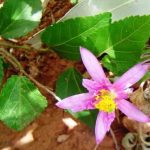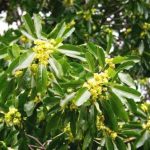TREE LIFE
March 2005
MASHONALAND CALENDAR
Tuesday 1st March. Botanic Garden Walk. Subject:“ Vegetation to be found on Termite Mounds “Meet Tom in the car park at 4.45 for 5pm.
Sunday 20th March. An all day joint walk with the Wildlife Society at Mukuvisi Woodlands – Blatherwick Road entrance.
Saturday 26th March. Mark’s walk this month is cancelled.
Friday 25th to Monday 28th March Easter Weekend. Arrangements have been made to visit Besna Kobila in the Matopos area. This is a large property with rivers, dams, vleis, kopjes and an enormous variety of plants.
It will be a self-catering week-end. Accommodation is in restored stables. There are showers, loos and a kitchen. Crockery, cutlery, gas plate, ice box etc. need to be brought with you. There is no electricity, but candles and wood will be provided. There are a limited number of beds, with bedding, mattress without bedding and ample space for camping.
The charges are:-
· camping $40000 per person per night,
· mattresses $60000 per person per night
· beds with bedding $80000 per person per night.
Please contact Maureen Silva-Jones
(H. 740479 or O. 757171) if you are interested and need more information and directions.
This will be our second visit to Besna Kobila and it is highly recommended.
MATABELELAND CALENDAR.
Please phone J P Felu on Bulawayo 232797 or Jonathan Timberlake on 286529 for details of the next Matabeleland function.
SUBSCRIPTIONS FOR 2005-6
The Tree Society’s subscription year is from 1 April 2005 to 31 March 2006 and once again it is my unpleasant duty to write to members advising them of the subscriptions for next year.
As you will recall, the Society used to produce a hard copy of Tree Life every month and post it out to all the members. However, rising postal costs and also paper and duplication costs forced us to review that approach and we have switched to sending out Tree Life as an email attachment.
The take-up has been good and the majority of members now receive Tree Life by email.
However, there has remained a proportion of the members who do not have email. Last year a 2-tier approach was introduced, with a higher charge for those receiving Tree Life by post.
However, during the year we have seen an extraordinary rise in the cost of postage to its current $6,900.
This rise, well above the official rate of inflation, has led the Committee once again to review the system we use for sending out Tree Life.
For 2005-6, there will be a three tier system.
- Those receiving Tree Life by email will pay $30,000.
- Those who wish to receive a hard copy of Tree Life and are willing to collect it (or in some cases delivery can be arranged) will pay $60,000.
- Those who wish to receive a hard copy of Tree Life by post will pay $150,000.
In effect we have removed the subsidy of those receiving by email and I imagine that at that price, postal deliveries will be strongly discouraged.
The Committee has always been worried that those members without email might be our poorest members who were least able to pay the higher amounts. I must emphasize that arrangements exist for the support of members (some members pay more than the required rates for this purpose). We would hate to lose people because of rising costs. Please talk to either me, Terry Fallon or Maureen Silva-Jones. All such requests will be treated confidentially.
If you are paying your subs by cheque, please make it payable to :-
GP2 – Account Tree Society
-Mark Hyde Chairman
DOMBOSHAWA: 16 JANUARY 2005
We had a good turnout of members on this day. Despite the time of year, the weather was fine and Domboshawa was looking relatively dry with less than usual amounts of water running down over the rocks.
The hazards of wet rocks (those which are black in colour are particularly dangerous) and slippery rocks (especially those where the leaves of the sedge Coleochloa setifera lie on the rocks) were present and I had a few uneasy moments with the older members of the group. However, fortunately, there were no accidents.
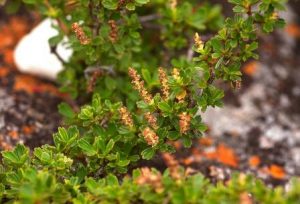
Myrothamnus flabellifolius. Photo: Bart Wursten. Source: Flora of Zimbabwe
The interesting assemblage of plants on this rocky hill was introduced to the newcomers. Prominent species included the Resurrection bush (Myrothamnus flabellifolius), Plectranthus sanguineus and everywhere the tufted sedge, Coleochloa setifera. Another species with resurrection-type characteristics is the fern ally, Selaginella dregei. Typically this species resembles a moss. We were able to show members both the grey dried-up from and the greenish wet form.
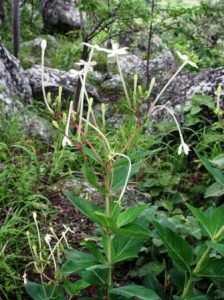
Pentas nobilis. Photo: Mark Hyde. Source: Flora of Zimbabwe
At this season of the year, the plant Pentas nobilis, with its white flowers with their very long corolla tubes, was in flower. Which pollinator, I wonder, is adapted to that long tube? Pentas is a herbaceous Rubiaceae and therefore has opposite leaves, stipules and an inferior ovary. (See also Tapiphyllum later).
The Lavender tree (Heteropyxis dehniae) is a common species at Domboshawa and in rocky places. The specific name commemorates Mrs Gertrude Dehn who was a collector of plants in the Marondera and Rusape areas.
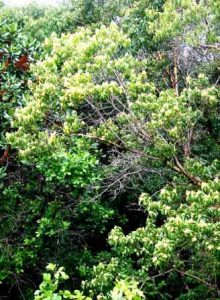
Heteropyxis dehniae. Photo: Bart Wursten. Source: Flora of Zimbabwe
This species has a number of interesting spot characters. Firstly, it has a distinctive trunk with peeling bark. Secondly, the leaves, which are arranged alternately, have translucent gland dots and are aromatic when crushed. The species is sometimes placed in the family Myrtaceae – with us this usually has opposite leaves, but it does share the characteristic of translucent gland dots.
Another feature of Heteropyxis is that the flowers are unisexual. And finally, the leaves bear acaradomatia (sometimes shortened to domatia), literally “houses for mites”. These are little hairy pockets on the underside of the leaf in the axils of the main lateral veins. On the upper surface are raised domes corresponding to the pit beneath and the raised domes are often more easily visible.
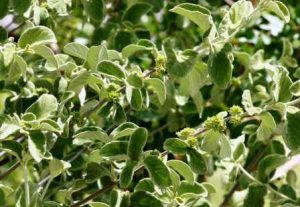
Tapiphyllum velutinum. Photo: Bart Wursten. Source: Flora of Zimbabwe
Another distinctive tree of these habitats is Tapiphyllum velutinum with its thick-textured greyish velvety leaves. This belongs to the family Rubiaceae with its opposite leaves and interpetiolar stipules. The bark of this species is rough and somewhat peeling, revealing a distinctive reddish under bark. The species is confined to rocky places.
Amongst the rocks was the pretty and distinctive fern, Actiniopteris dimorpha. This fern has dimorphic fronds: the fertile fronds are larger than the sterile ones. It grows in the cracks of rocks.
Another plant species of rocky places is the small pink-flowered species: Portulaca rhodesiana. This tiny plant has succulent leaves and grows in small patches of soil on bare rocks. It is endemic to Zimbabwe. Around the wetter parts of the rocks were tiny species of Lindernia (Scrophulariaceae) looking very striking with their relatively large blue flowers.
We also stopped to look at the tiny carnivorous plant, Drosera indica. Pink flowers were seen as well as the gland-tipped hairs on the leaves.
On the way up, we re-visited the colony of Streptocarpus pumilus. This is a tiny species, one of the few which extends out of the high rainfall Eastern Highlands. It occurs here under the overhang of a boulder and is a very attractive species with purple flowers; although nothing like as impressive and spectacular as its eastern relatives.
From there to the summit, there were absolutely no trees for the Tree Society, nor indeed were there hardly any flowering plants. Perhaps a few lichens only. There was no excuse for stopping and, out of breath, we achieved the beacon on the summit and from there admired the view.
From the summit we saw an impressive storm deluging rain in the distance and thinking it was coming our way began quickly to descend. However, apart from a few spots it missed us and we were able to eat our lunch in comfort at the bottom.
All in all, it was a varied and interesting day of botany at one of our favourite spots.
-Mark Hyde
Greetings from the Haxens in Australia.
For those that have not heard our news for some time, a quick update. We left Zimbabwe and arrived in Australia in January, 2001. We decided to come to Toowoomba (+ 100km west of Brisbane) as we already knew a few Zimbabweans here and we knew that it was of a size and had the sort of climate that we could cope with. Also, since we were on a business visa we felt that there were advantages to being in a ‘regional’ centre.
After finding schools for Jemima and Kenneth we set about looking for a business which we felt we could run without too steep a learning curve and bought a café in a shopping centre in April, 2001. We needed something fairly easy and something which would meet the requirements in due course for an application for permanent residence. Café Restpoint succeeded in this regard and won us permanent residence in December 2002. In the meantime Jessica started on a B. Biotech at University of Queensland in Brisbane in July 2001, eventually converting to a B.Sc. Whilst the café was OK for migration purposes, it was not a business success as the rent and staff costs were really too high for its potential turnover, so we set about trying to sell it, which we succeeded in doing in February 2004. This was a great relief to us, even though we sold at a considerable loss, as we were really only breaking even and living off capital. We were now free to find employment which we felt was more to our liking than running a business!
So I went from being a cafe proprietor to being a cabbie to being a call centre operator and soon to be a born-again law student (I think). Cheryl found a job (with the help of a Zim connection) in the labs of Dairy Farmers, the local equivalent of DMB, and she is reasonably happy there-testing cheeses, butter and milk powders for various bacteria/fungi and molds which everyone here is paranoid about. No doubt we ate a mountain of these in Africa and are stronger as a result.
Jessica finished her BSc majoring in genetics and molecular biology, but has not had any good job offers, so is still a waitress at the Angel Cafe here in Toowoomba. Jemima finished 2 years of school (Glennie) here and went to London on a 2 year working holiday visa and is due to return in May 05 although she is a bit vague about this, having found a taste for travel. She has work with the London fire dept and also works as a silver service waitress at weekends. She has really seen some amazing things at this job— the embassy of an impoverished country throwing lavish parties on a massive scale in their London mansion; movie premiers with all the stars and how the rich have a day out at Royal Ascot. Ken finished school (Concordia College) in 2003, has worked for a year for Pacific Seeds (similar to Seed Co) and is now about to start a visual arts degree course here in Toowoomba at the University of Southern Queensland.
We are still happily settled in Toowoomba where we have a fairly modest house overlooking the dividing range escarpment. We have a nice garden on 1500 m2 and have planted a lot in it, particularly Australian natives. We even have 2 musasa seedlings grown from seed collected in the botanical gardens, but we haven’t dared to plant them out yet. We have Kookaburras, a blue-tongued lizard and the odd possum, plenty of butterflies, flying foxes and lots of parrots and other birds and spiders everywhere including plenty of the notorious redbacks and some fascinating tree-dwellers called bolas spiders. We are considered insane by various family members for tolerating these co-habitants of our environment.
We are members of two societies here – the Toowoomba Society for Growing Australian Plants (SGAP) and the Toowoomba Field Naturalists (TFN), and between them we have found much to stimulate our interest. We have been on many rewarding outings and weekends and I have to admit that we have learned to love both gums and wattles! The botanical learning curve is steep, but there is also much with which one is familiar or one can identify with. Some Australian ‘natives’ are identical to Zimbabwe species, for example Dodonea viscosa and Trema orientalis. Others are very similar to what we knew, for example Erythrina vespertilio (much like E. lysistemon)-called a lucky bean in Zimbabwe – and the dozens of species of Syzygium similar to the waterberry we enjoyed eating on Tree Soc outings in Zim. Then there are plenty which are very different indeed! There is a big range of environments close by including magnificent rainforests with Antarctic beeches, ancient survivors of Gondwanaland, and of course the ocean and the Barrier reef.
We have lots of ex-Zimbabwe friends and acquaintances in Toowoomba, some of which we knew in Zimbabwe (like Ken & Luanne Cunliffe, John & Jean Hill, Maureen & Quin Staff) but many of whom we didn’t know there but have come to know because of the social Zim community we have here. We have also come to know lots of Aussies through work and the societies, etc, so we don’t feel that we are in an exclusive Zim clique.
It is impossible to express how much we miss you all even though we are notoriously poor communicators. During long hours baking muffins in the early mornings in the café and now doing micro work in the lab (Cheryl here now) I go over the great times we had with friends and family in Zim; the wonderful outings with the Tree Society; Musicamps at Marondera and the trips to the Zambezi valley and other bush trips over the years. On the positive side we have had visits from quite a few friends and relatives and managed to spend New Year 2002 in New Zealand where at one point we had a group of 25 relatives -termed rellies here in Aus- together in one place. Good thing we did this as a few months later our passports expired (Philip’s and mine that is) and all attempts at renewing proved fruitless, as the goalposts seemed to shift at every stage. We finally had to accept that we had been unceremoniously stripped of our Zim citizenship and became stateless for at least the two years from attaining permanent residence status to citizenship. In this regard we have just applied for citizenship and hope there will be no hitches. We so look forward to calling Australia home without any uncertainties as to the future. Ironically our status was less secure than that of our 4 cats which we insanely imported. We were convinced that they would instantly commit suicide on the road after their release from quarantine but we have now had three and a half years with them and they make us laugh a good deal. They are extremely fat. We have found some consoling distractions to missing the old life and friends.
Being interested in the wildlife and environment has been a big help and we have also found that between Toowoomba, Brisbane and the nearby Gold Coast there is plenty of entertainment. The local University has excellent music and Drama Depts. And there is a beautiful restored Theatre whose patron is Jeffrey Rush who is apparently originally a Toowoomba boy. We have now seen Bob Dylan; Neil Young, The Fureys, Don MacLean (yes he sang the whole of ‘Bye-bye miss American Pie’ as well as ‘Vincent’) Arlo Guthrie, Maddy Prior -twice- once as a solo artist and then the next year with Steeleye Span who we last saw in London 15 years ago; Eric Bogle; America-the group not the country; Sarah Brightman; The Chieftains; Santana; and Bruce Springsteen and Jose Feliciano. We are now booked to see Cher’s farewell tour and Mark Knopfler – former Dire Straits guitarist. Missed with regret-Red hot Chilli Peppers, Eagles, Kiss, Marianne Faithful and Rolling Stones and Pearl Jam (perhaps they will come back). As you can see it is hard to find enough hours to work to earn enough to get to all these performances. In the midst of all this plenty I still pine for Johnny Clegg and his Zulu-fusion music. We still have to get to some of the great festivals they have here like the Woodford and Port Fairy folk festivals and Womadelaide world music festival to mention a few.
Good luck everyone and have a happy New Year! Just in case any of you are heading here for a visit our address is 2 Gregory St, Toowoomba 4350 Qld; phone (07) 46387812. We have lost track of quite a few e-mail addresses so if any of you know of anyone who has not received this mail please send it on to them.
Phil and Cheryl
THE PETHERAM FILES Continued…..
South African Fossil Beds
Reproduced below is the edited text of a cutting from South African Panorama, January 1966, which was found in File 3. The introductory paragraphs were missing, as were parts of at least three illustrations. The colour and black-and-white photographs accompanying the article illustrated (1) a Glossopteris leaf with a fructification attached to the midrib, (2) a winged seed of Samaropsis sp, the parent plant of which has not yet been identified, (3) a Glossopteris fruiting body, named Scutum leslium, lying next to a Glossopteris leaf, (4) Hirsutum dutoitides, the fructification of Glossopteris indica, (5) a portion of a large, fern-like leaf of Gondwanidium validum, (6) a leaf of Glossopteris browniana with a fructification named Scutum leslium, (7) leaves of two of the most common species of Glossopteris (neither of them named), (8) impressions of leaves of Glossopteris and Gangamopteris, (9) a lobed leaf of one of the most ancient relatives of the modern maidenhair tree, Ginkgo biloba, and (10) an interesting fossil, Lerouxia transvaalensis, possibly the reproductive organ of some earlier ancestor of modern flowering plants.
Rich fossil beds of the Glossopteris flora, discovered near Vereeniging in South Africa, have revealed some easily recognized ancient relatives of certain modern plants. Others are completely extinct and have no living representatives.
The dominant plant of the time bore simple leaves resembling those of modern-day eucalypts. The leaves were generally tongue-shaped, hence the name Glossopteris (tongue fern). These plants were unique in their mode of propagation, for they bore peculiar bisexual fructifications on pedicels attached to the midribs of the leaves. Intensive research by Dr Edna Plumstead, a well-known South African palaeobotanist, has revealed that Glossopteris had several close relatives showing similar modes of propagation. These plants are all included in a new botanical class, the Glossopteridae, all members of which are extinct.
The swampy landscape of those ancient times must have presented a rather dismal picture, composed mainly of vast stretches of water broken by numerous patches of monotonous green. Somewhere in the depths of this eerie world, where no bird song was ever heard, there were strange plants on which exotic flowers bloomed, judging by the discovery of some peculiar flower-like fossils in the Vereeniging beds. Superficially, at least, these fossils strongly suggest ancestral relationship to modern flowering plants.
These forests also sheltered a group of plants known as pteridosperms (seed-bearing ferns), which have no living representatives. They were fern-like in some respects, but unlike true ferns they bore seed instead of spores.
The conditions prevailing in the forests were favourable for the establishment of another group of ancient plants, known as lycopods, which were the ancestors of modern mosses and quillworts. Unlike the modern mosses, the early lycopods were often large—sometimes even gigantic. The stems were sometimes forked, but bore no lateral branches. Narrow, linear leaves were borne directly on the stems, and left peculiar scars when they were shed. Propagation took place by spores produced in cone-like structures.
Among the most conspicuous contemporaries of Glossopteris were stately trees with tall, straight stems bearing clusters of long, narrow leaves with parallel veins near the top. In general, they probably resembled certain recent pines. Growing side by side with these were trees of a different nature, bearing lobed leaves with forked veins. The trees belonged to the order Ginkgoales, of which the only living member is the maidenhair tree, Ginkgo biloba.
The Rape of Our Heritage
The material below is taken from a cutting from The Sunday Mail 2 October 1983. It appeared under the heading “Fossilized wood part of our heritage”.
Crooked dealers are paying unsuspecting rural people to collect petrified wood in contravention of the law. Mr Vic Levey, public relations officer for the National Museums and Monuments of Zimbabwe, last week appealed to retailers and curio-shop owners not to accept specimens of the fossilized wood not covered by an official Museums permit.
“The commercial potential of petrified wood has been realized for many years, and in the past, under the controlled issue of permits, it has been collected and manufactured into ornamental objects sold through various retail outlets”, he said.
Exports of petrified wood had also been a valuable foreign currency earner for Zimbabwe.
“Today this commercial potential is being abused and exploited by unscrupulous dealers who bribe innocent members of the rural population to locate and extract quantities of petrified wood without applying for the required permits, or approaching the proper authorities.
“The unauthorized removal of petrified wood from its original location contributes to the rape of our natural and historical heritage”, Mr Levey said.
The fossilized remains of trees that were part of Zimbabwe’s prehistoric landscape are protected under the National Museums and Monuments Act, which requires that all types of material evidence of Zimbabwe’s prehistory and natural evolution.
Under the law, fossilized wood and all fossils are defined as relics, along with other items dated before 1890, including pottery, metalcraft, beads, stone implements, and human bones.
“It is both impossible and impractical to police the vast areas in which petrified wood occurs”, Mr Levey said. “The solution, therefore, is to create an awareness among local authorities, and, through them, among the local populations of preserving the limited evidence of our prehistoric past”.
“Anyone found in unauthorized possession of any historic relic faces prosecution”, Mr Levey said.
Fossilized trees belong to the Triassic period of Zimbabwe’s prehistory, and are about 200 million years old. Two main types of petrified wood are found in different parts of Zimbabwe. The most common has a green tinge, and is the fossilized remains of an extinct cone-bearing tree known as Dadoxylon. Less plentiful are the remains of an extinct, vine-like plant known as Rhexoxylon, which was probably also cone bearing.
In the fossilization process the wood tissue is replaced detail-for-detail by minerals, leaving the original patterns of the wood and the tissue structure clearly visible. Growth rings in a cross-section of the trunk, showing the annual seasons when the trees were growing, also make petrified wood attractive for ornaments, such as stone eggs and paperweights.
-Lyn Mullin To be continued.
HISTORIC TREES OF ZIMBABWE By LYN MULLIN.
Copies of this wonderful book are still available from Maureen Silva-Jones.
Telephone. Home 740479; Work 757171(Harare)
Prices:
Hard Cover – $150 000
Leather Bound – $200 000
MARK HYDE CHAIRMAN


